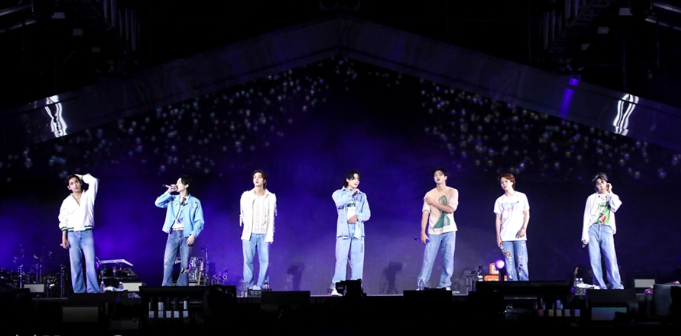Korean pop, commonly known as K pop, is a musical genre that has seen explosive growth in popularity across the globe, originating from South Korea.
Characterized by an eclectic mix of sounds drawn from pop, hip-hop, R&B, and electronic dance music, K-pop is much more than just music. It represents a multifaceted cultural phenomenon encompassing fashion, dance, production, and fan culture.
Its roots in the South Korean music scene are deep, and it has now become a significant exporter of Korean culture, often referred to as the “Korean Wave” or “Hallyu.”
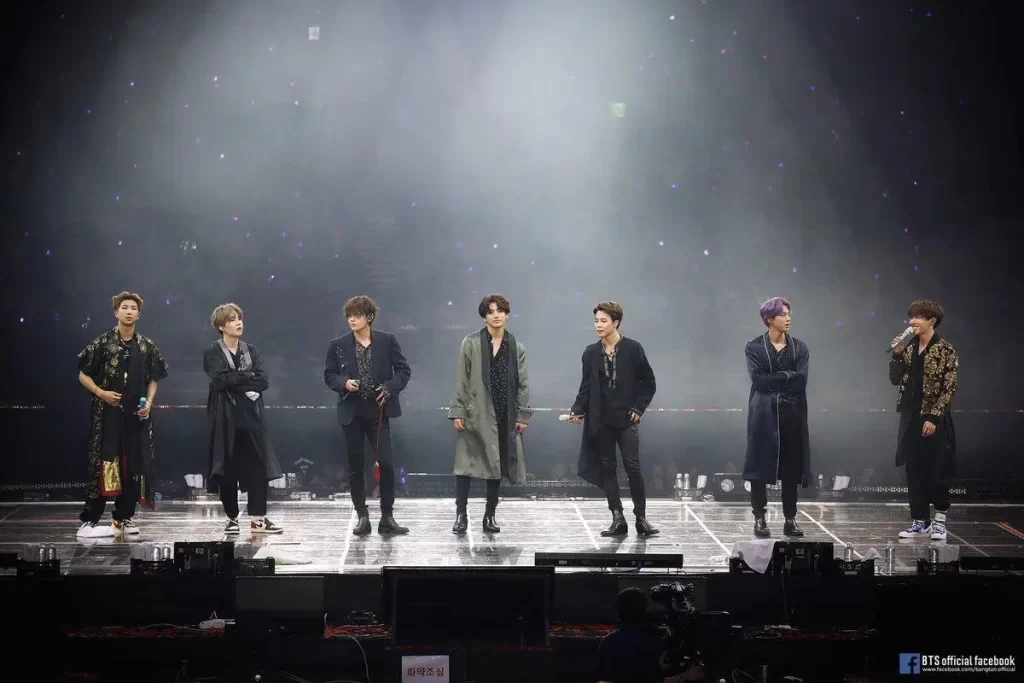
The global impact of K-pop is undeniable. It continues to influence music, style, and entertainment internationally, bolstered by highly synchronized dance routines and aesthetically pleasing music videos that appeal to diverse audiences.
The genre’s history includes its origin, evolution, and the key players who have shaped its growth—pioneering groups alongside today’s chart-topping acts like BTS and Blackpink have been instrumental in bringing K-pop to the world stage.
Moreover, K-pop is a digital-era phenomenon that has harnessed the power of social media and dedicated fan bases to reach listeners worldwide. Its fans are not passive consumers; they form communities, contribute to promoting their favorite artists, and engage with the music on numerous online platforms.
With its vast array of sub-genres and styles, K-pop is a dynamic and influential cultural export that continues to evolve and expand its reach.
History of Korean Pop
Korean pop, widely known as K-pop, is an influential music genre that has experienced a dramatic evolution over several decades. Emerging from South Korea, K-pop initially integrated various musical styles, including pop, rock, R&B, electronic, and hip-hop.
This section will explore critical milestones and entities that have shaped the genre.
The evolution of K-pop can be segmented into four main generations, each marked by distinct styles, trends, and influential artists that have contributed to the genre’s international popularity.
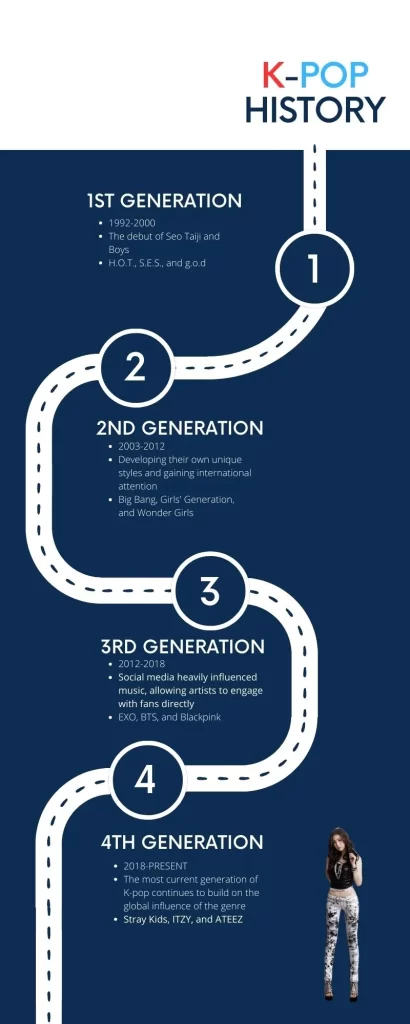
First Generation K-pop (1992-2000)
This era began with the debut of Seo Taiji and Boys in 1992, whose integration of Western genres like hip-hop and R&B with Korean music set the stage for modern K-pop.
They are often credited with the birth of the genre. Other representative artists from this generation include H.O.T., S.E.S., and g.o.d.
Second Generation K-pop (2003-2012)
The second generation saw K-pop artists developing their unique styles and gaining international attention. This period included the rise of iconic groups like Super Junior, Big Bang, Girls’ Generation, and Wonder Girls.
Catchy melodies, synchronized dance routines, and the beginning of the global spread of K-pop through the internet characterized the music.
Third Generation K-pop (2012-2018)
K-pop’s third generation was marked by the genre’s explosive international growth, with groups like EXO, BTS, and Blackpink becoming household names worldwide.
The music produced during this time was heavily influenced by social media, allowing artists to engage with fans directly and spread their music more widely.
Fourth Generation K-pop (2018-present)
The most current generation of K-pop continues to build on the genre’s global influence, with groups like Stray Kids, ITZY, and ATEEZ pushing the boundaries of K-pop’s sound and presentation.
Platforms like YouTube and TikTok have been instrumental in K-pop’s continued global reach and evolution. These generations show the dynamic progression of K-pop from its inception to its current status as a worldwide phenomenon.
Genre and Musical Influences

Korean Pop, or K-pop, has a rich tapestry of musical influences that range across numerous genres, incorporating an eclectic mix of sounds and styles. The genre has evolved over the years, embedding itself with diverse cultural melodies and encompassing various emotions through lyrics and music.
Incorporation of Various Genres
K-pop is famously known for integrating a wide array of musical genres. It is not unusual for K-pop songs to blend elements of:
- Pop
- Rap
- R&B
- Rock
- Electronic Dance Music (EDM)
- Jazz
- Folk
Including genres such as disco, soul, reggae, and Latin influences contribute to K-pop’s distinctive sound. Moreover, the infusion of traditional Korean music elements can sometimes be heard, giving K-pop a unique cultural touch that helps it stand out in the global music industry.
Evolution of Sound and Style
Initially, K-pop drew heavily from genres like new jack swing, hip-hop, and bubblegum pop. But as the industry progressed, the sound evolved.
For instance, the emotional depth of ballads and the rhythmic allure of trot and funk have been woven into K-pop’s fabric.
Today, K-pop artists and producers are known for their innovative approach to music-making, often experimenting with:
- Melodies: Creating catchy hooks that are memorable and widely appealing.
- Lyrics: Utilizing a mix of Korean and English phrases to widen audience reach.
- Emotions and Color: Each K-pop group or artist has a unique concept that often carries a particular emotion or color, influencing their style and the thematic content of their music.
The layering of complex harmonies, intricate musical transitions, and a strong emphasis on visual performance has become a signature aspect of the genre. Furthermore, K-pop is heard and visually experienced through vibrant music videos and dynamic live performances.
Industry Dynamics

The Korean pop (K-pop) industry is a complex ecosystem characterized by a few major entertainment companies orchestrating the development of K-pop idols. These companies play a pivotal role in shaping the industry’s collective identity and ever-changing landscape, which has now embraced streaming as a major platform for consumption.
Major Entertainment Companies
The K-pop industry is predominantly governed by major entertainment companies such as SM Entertainment, YG Entertainment, JYP Entertainment, and Big Hit Entertainment.
They are the industry’s bedrock, often called the “Big Four,” and are instrumental in the global recognition of K-pop. They differ in style, management, and strategic approaches but share a common goal: to propel Korean culture onto the world stage.
Big Four Entertainment companies and their artists:
| Entertainment Company | Description | Notable Groups |
|---|---|---|
| SM Entertainment | Known for pioneering the “idol culture,” SM is one of the first players in the K-pop industry and has produced successful groups like Girls’ Generation and EXO. | Girls’ Generation, EXO |
| YG Entertainment | With a focus on edgier and more hip-hop-influenced sounds, YG is home to artists like BIGBANG and BLACKPINK. | BIGBANG, BLACKPINK |
| JYP Entertainment | Emphasizing personality and talent, JYP houses popular groups like TWICE and GOT7. | TWICE, Stray Kids |
| Big Hit Entertainment | The newer giants, known as HYBE, propelled BTS to international fame, redefining what a K-pop group could achieve globally. | BTS, TOMORROW X TOGETHER |
Training and Development of Idols
The process of creating a K-pop idol is meticulous and strategically planned. Trainees often spend years in intense training environments before they make their debut.
During this period, they receive rigorous training in various disciplines. Here are the core aspects:
- Vocal and Dance Training: Every idol must excel in performance arts with daily practice sessions.
- Language and Media Strategy: Trainees are often taught multiple languages and groomed on how to present themselves in media.
- Fitness and Diet: Maintaining aesthetic appearances with specialized diets and fitness routines is paramount.
Companies invest significant resources in training these individuals, who could potentially change the industry’s direction with their innovations and unique talents.
The idol system is a distinctive feature of the K-pop industry. Each company’s philosophy and methodology collectively contribute to a vibrant and dynamic K-pop scene.
K-Pop Groups and Solo Artists
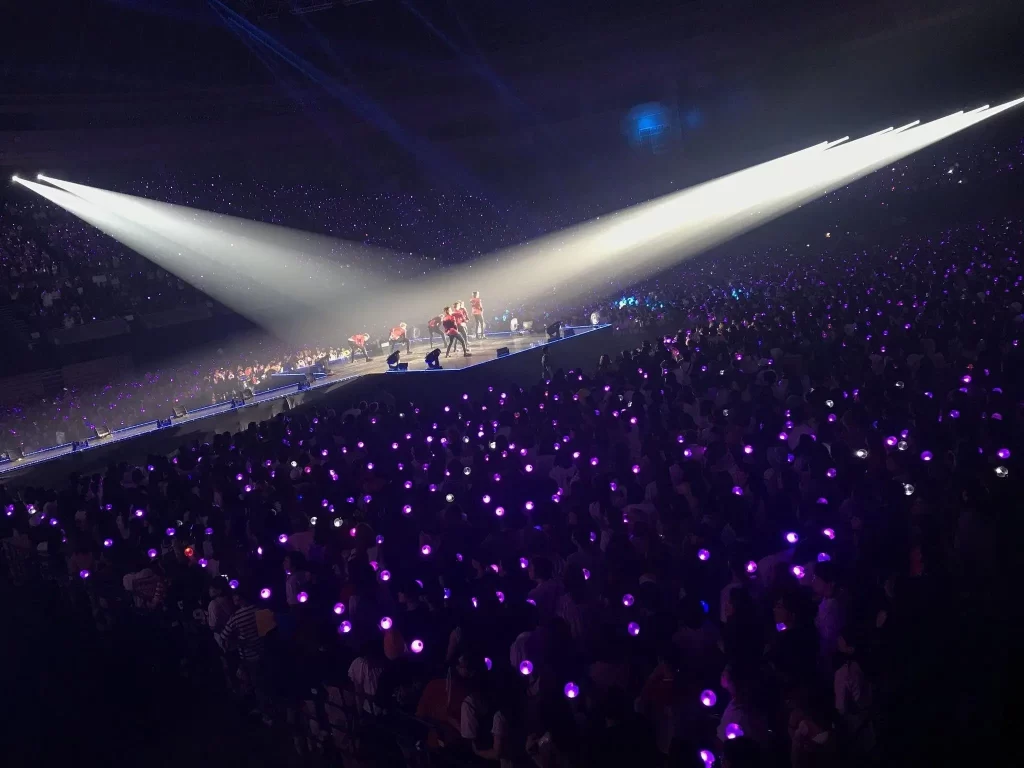
Korean Pop, or K-pop, has become an international phenomenon with roots in various musical genres.
Encompassing highly choreographed dance routines, distinct fashion, and a blend of vocals and rap, the scene is dominated by boy bands, girl groups, and a growing number of solo artists who have achieved global recognition.
Boy Bands and Girl Groups
K-pop is home to some of the most prominent boy and girl groups, each with a unique style and fan base. BTS, one of the most influential boy bands globally, has spearheaded the Hallyu wave with catchy tunes and impactful social messages.
Girl groups like BLACKPINK and TWICE have also gained international acclaim with powerful performances and hit songs.
- BTS: A cultural phenomenon with awards and chart-topping tracks
- BLACKPINK: Noted for their fierce style and global reach
- TWICE: Combining catchy melodies with synchronized choreography
- Red Velvet, EXID, and (G)I-DLE: Contributing diverse sounds and styles
Solo Artists and Breakouts
Amidst group acts, individual idols have also carved out successful solo careers.
IU has had a prolific solo career as a singer-songwriter known for her vocal ability and storytelling through music.
BoA is another solo powerhouse pioneer who internationally paved the way for other K-pop artists. From BLACKPINK, Rosé has stood out with her characteristic voice and solo projects.
Rising Stars and Newcomers
The K-Pop industry continually sees a stream of new talent.
Groups like Stray Kids, Tomorrow X Together, and IVE offer fresh takes on the genre and are quickly gaining popularity.
STAYC has also emerged as a promising girl group, enchanting fans with youthful energy and strong vocal performances.
Soloist Jay Park showcases the versatility of K-pop through his fusion of rap, R&B, and dance, illustrating the genre’s ongoing evolution.
Cultural Impact and Globalization
Korean pop music, K-pop, has transcended its original boundaries to become a global sensation. This shift is marked by its significant influence on international music charts and integration into various facets of pop culture.
International Recognition and Charts
Korean pop music has made impressive inroads into the global music scene, gaining recognition on prestigious music charts.
Notably, K-pop acts like BTS and BLACKPINK have consistently secured positions on the Billboard Hot 100 and received coverage in influential outlets like Rolling Stone.
BTS’s singles “Dynamite” and “Butter” achieved number-one spots on the Billboard charts, signaling a growing international consumption of Korean music.
Influence on Global Pop Culture
The reach of K-pop extends beyond music to influence global pop culture.
Its unique blend of catchy melodies, high-production value, and dynamic choreography commands a significant presence on social media platforms like TikTok, where dances and songs often go viral.
Additionally, Korean pop music’s aesthetics and fashion have set international trends, showcasing South Korea’s soft power.
- TikTok Challenges: K-pop songs are often core to viral dance challenges.
- Fashion Trends: Idols’ fashion choices are emulated by fans globally.
Collaborations with International Artists
K-pop’s globalization includes collaborations with worldwide celebrities, expanding its reach.
Collaborations have introduced Korean pop music to diverse audiences and often resulted in songs that blend the Korean language with English, creating a unique crossover appeal.
These international partnerships have demonstrated K-pop’s versatility and adaptive nature as a genre.
K-Pop in Cinema and Dramas
K-pop’s influence has permeated the drama and cinema sectors, amplifying its cultural impact.
The popularity of K-pop has led to the inclusion of its music in soundtracks and its stars crossing over into acting roles.
This interaction between music and screen media has played a critical role in the international success of both industries, solidifying K-pop as an essential element of contemporary Korean cinema and television productions.
The Role of Media
In K-pop, media plays a central role in shaping artists’ global presence and connecting with fans. As a highly visual and interactive sphere, K-pop’s reliance on media amplifies its music and becomes part of the experience.
Importance of Music Videos
Music videos are integral to K-pop, a powerful medium to showcase the genre’s dynamic choreography and storytelling.
They are vital for the following reasons:
- Exposure: Music videos provide a visual platform for K-pop’s music, reaching a global audience beyond South Korea.
- Artistry: These videos often feature elaborate dance sequences and intricate cinematography, highlighting the performers’ dancing skills.
- Engagement: With eye-catching visuals, music videos captivate and engage K-pop fans, enhancing their connection to the music and the artists.
Furthermore, music videos enhance the play dimension of K-pop by incorporating engaging narratives, extending the song’s impact beyond just the auditory experience.
K-pop artists leverage social media to share snippets of their music videos or entire videos, which fans eagerly share and discuss, fostering a community around shared visual content.
The choreography in these videos often goes viral, with fans replicating dance moves, thus multiplying the music’s reach.
This symbiosis between K-pop and media underscores the importance of creative video content in the genre’s global proliferation.
Visual Accessibility:
- View count: The popularity of a K-pop music video can often be quantified by its view count on platforms like YouTube, serving as a metric for popularity.
- Global reach: Enabled by the ubiquity of video sharing, K-pop music videos transcend language barriers and bring K-pop to an international audience.
Fandom and Community
K-pop fan communities are massive, global, and essential to the cultural phenomenon that K-pop represents. These fans exhibit remarkable levels of dedication and engage in various forms of interaction that further the reach of the music and the artists.
Social media platforms have been instrumental in shaping the fandom and facilitating its growth.
Fan Engagement and Interaction
K-pop fans have developed a culture of high engagement around their favorite artists. They take their support to the next level, employing various methods to interact not only with the K-pop stars themselves but with one another:
- Fan Projects: These can include organizing events, fundraising for charitable causes, or creating support materials for new music releases.
- Fan Chants: During concerts, fans often shout synchronized chants to show solidarity and support.
- Content Creation: Many devote their time to creating fan art, dance covers, or reaction videos, further fueling the popularity of K-pop.
Moreover, fans actively engage on various platforms because they anticipate a reply or interaction from a celebrity through a direct message (DM) or a mention.
Role of Social Media in Fandom Growth
Social media has been the cornerstone of the exponential growth of K-pop fandoms, with platforms like Twitter and Instagram serving as hotspots for fan activity:
- Real-Time Updates: Fans rely on official accounts for instant news, which leads to a constant state of waiting for updates and content drops.
- Global Connectivity: Social media breaks geographical barriers, allowing fans worldwide to bond over shared interests.
- Hash-tagging Campaigns: Fans often use hashtags to trend topics, celebrate anniversaries, or support comebacks.
The table below showcases a quick overview of social media usage among K-pop fandoms:
| Platform | Purpose | Impact on Fandom Growth |
| Real-time updates, fan projects | High | |
| Visual content, story features | Moderate |
Economic Significance
The expansion of K-pop has positioned it as a significant driver in South Korea’s economy. It contributes significantly to its GDP through various revenue streams and bolsters tourism.
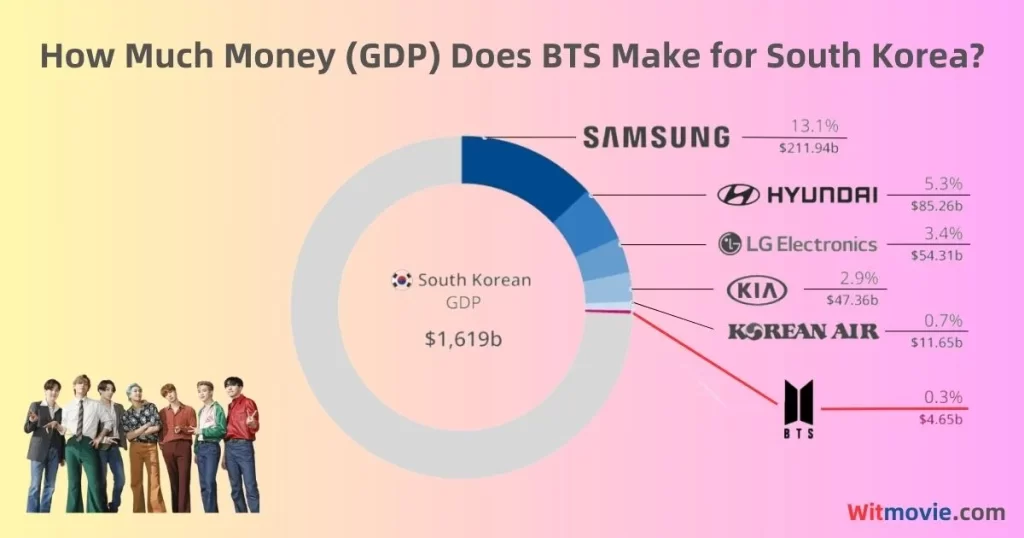
Contribution to the South Korean Economy
The surge in K-Pop’s global reach has translated into substantial economic benefits for South Korea. This genre’s influence, often termed “Hallyu” or the “Korean Wave,” represents a cultural phenomenon that drives the nation’s export sector and cements its cultural footprint worldwide.
In particular:
- Popularity: K-pop has magnetized an international audience, cultivating devoted fan bases across the globe.
- Revenue: K-Pop’s overall impact on South Korea’s economy was estimated to be over USD 5 billion in 2020, with expectations for continuous growth.
- Tourism: K-pop has also dramatically increased the flow of tourists wishing to engage with the culture that produces their favorite music and artists.
Merchandising and Brand Endorsements
Merchandising and brand endorsements form a vital part of K-pop’s economic significance:
- Merchandise Sales: Various products, from apparel to accessories and album copies, contribute to the genre’s commercial triumph. For instance, K-pop merchandise has raised over USD 114.5 million in revenue, highlighting the fandom’s lucrative business.
- Brand Endorsements: K-pop artists frequently partner with brands, leveraging their expansive influence for mutual benefit. Their endorsements can lead to significant sales increases for products in multiple sectors.
Moreover, the industry’s focus on merchandise has led to an influx of retailers, creating jobs and stimulating domestic commerce. The international demand for these products further emphasizes K-pop’s role in South Korea’s export growth.
What is the Most Popular Korean Pop?
Korean pop, commonly known as K-pop, has surged globally over the past few years.
It is a music genre from South Korea characterized by various audiovisual elements.
The genre’s popularity is not confined to the music alone but extends to fashion, dance, and music videos.
In discussing the most popular K-pop, several entities stand out, specifically:
- Historic Milestones of the genre
- Key Artists that define K-pop
- Chart Performance indicating popularity
Historic Milestones
K-pop has seen numerous milestones that have advanced its international appeal.
The genre has transcended language barriers and cultural differences to capture a diverse audience worldwide.
Key Artists
Among K-pop artists, BTS and Blackpink are two groups that have achieved phenomenal success domestically and internationally.
Their music has led the charge regarding K-pop’s recognition on global platforms.
- BTS (Bangtan Sonyeondan), a seven-member boy band, has revolutionized K-pop’s international prevalence.
- Blackpink, the widely acclaimed girl group, has similarly globalized the reach of K-pop with chart-topping hits and international tours.
Chart Performance
Chart performances can also measure the popularity of K-pop.
Albums and singles by K-pop artists frequently rank highly on charts worldwide, indicating their wide-reaching popularity.
For instance, the Billboard K-Pop Artist 100 is a notable indicator of K-pop artists’ standing.
What is Korean Pop Music?
Korean Pop, commonly known as K-pop, is a genre that has transformed the international music scene with its unique blend of sounds and visual elements.
This South Korean music wave encompasses a variety of musical styles, primarily influenced by pop, hip-hop, R&B, and electronic dance music (EDM).
Historical Context
Korean pop music’s origins can be traced back to the early 1990s when idol groups were formed.
Over the years, it has evolved into an expansive industry known for its diverse musical influences, elaborate music videos, synchronized choreography, and rigorous and highly competitive idol training system.
Global Impact
Groups like BTS and Blackpink have pushed K-pop into the global limelight, achieving immense popularity and influence beyond South Korea’s borders.
These groups command sizeable fan bases worldwide and have made significant inroads into international markets, often breaking records on streaming platforms and social media.
Cultural Infusion
K-pop is not just about the music. Its appeal also lies in its:
- Integration of different genres
- Fashion trends set by idols
- Lyrical content that often includes multiple languages
- Fan engagement through social media
Furthermore, K-pop acts are known for their fan-centric approach, with fandoms playing a vital role in promoting and consuming K-pop content.
Core Elements
The core elements shaping the K-pop phenomenon include:
- Catchy Music: Melodic hooks and vibrant rhythms are staples.
- Visual Aesthetics: Music videos often feature cutting-edge production.
- Idol Culture: Training of idols is rigorous, molding multi-talented performers.
Additionally, fan meetings and K-pop concerts are integral to the K-pop experience, drawing crowds eager to see their favorite artists perform live.
What is the difference between K-pop and Korean Pop?
K-pop, or Korean Pop, is a contemporary musical genre from South Korea characterized by various audiovisual elements.
While “Korean pop” encompasses all popular music genres emerging from Korea, K-pop is specifically known for its unique blend of addicting melodies, slick choreography, and production quality.
Incorporating various musical styles, such as pop, hip-hop, R&B, and electronic dance music, K-pop has risen to international fame through its distinct and influential culture.
Historical Emergence
- Korean Pop: Originated in the mid-20th century, influenced by various traditional and Western genres.
- K-pop: It emerged in the early 1990s with the formation of groups like Seo Taiji and Boys, which infused Western musical styles with Korean lyrics.
Language and Reach
- Korean Pop: Encompasses music sung in Korean from various genres and artists.
- K-pop: Primarily performed in Korean but often includes English phrases to widen global appeal.
Global Influence and Fanbase
- K-pop: Notable groups such as BTS and BLACKPINK have garnered a massive international following, propelling the genre to a global platform.
Industry Structure
- K-pop: Entails rigorous training systems for idols and is known for its entertainment companies’ strong influence on artists’ careers. These entertainment companies operate as comprehensive brands, often shaping the identities and musical styles of the groups they manage.
Visual and Performance Art
- K-pop: Renowned for high-budget, dynamic music videos and captivating live performances that exhibit precise choreography and vibrant visuals.
Is it Korean Pop or K-pop?
Korean Pop, often abbreviated as K-pop, is a musical genre from South Korea that has experienced explosive international growth.
This section will discuss the terminology used for this genre and its cultural implications.
The Terminology of Korean Pop
While “Korean Pop” explicitly defines the genre as popular music from Korea, “K-pop” has become the quintessential shorthand for the music and the entire subculture and industry it has spawned.
Korean pop encompasses a broader spectrum of musical styles and influences while:
- K-pop is often characterized by its addictive melodies, slick choreography, and vibrant productions.
Moreover, K-pop is not only a genre—it is a cultural marker that represents the Hallyu wave, a term used to describe the global popularity of South Korean entertainment and culture.
Global Recognition as K-pop
As it gained global popularity, the term “K-pop” has been adopted worldwide to refer to the highly stylized, energetic, and production-rich music videos and live performances made famous by groups like BTS and BLACKPINK.
These have been vital elements in shaping K-pop’s identity, illustrating the genre’s uniqueness beyond the geographic descriptor “Korean.”
Industry and Social Implications
The industry surrounding K-pop includes music production, fashion, dance, and even language learning.
It is a phenomenon that has:
- Fostered a deep fan culture
- Influenced social media trends
- Propelled the genre to a multi-billion-dollar industry standing
Why is Korean Pop so popular?
Korean Pop, commonly called K-pop, has become a worldwide cultural sensation.
This phenomenon encompasses a range of elements such as music, dance, fashion, and a dedicated fan base.
Its popularity includes high production value, idol groups like BTS and BLACKPINK, elaborate choreography, and an active online community.
High Production Values and Catchy Hooks
Korean Pop is known for its high production values. Music videos and stages often feature elaborate sets and cutting-edge technology.
A signature of K-pop is its catchy hooks, designed to capture the listener’s attention and are a staple in the industry.
Idol Groups and Global Influence
K-pop is represented by iconic groups such as BTS and BLACKPINK, who have attained global recognition.
These groups release music, embark on world tours, meet fans, and act as cultural ambassadors for South Korea.
Choreography and Performance
Choreography is a pivotal part of the K-pop experience, with dance routines that often go viral.
Complex and highly synchronized, these dances enhance the appeal of K-pop songs and performances.
Engaged Online Community
An engaged online community underpins the K-pop industry.
Fans organize around the globe, sharing content and organizing events, contributing to the international spread of K-pop.
They also prominently promote groups via social media, stream music, and vote in music charts.
- Bullet point format for quick recollection:
- High production values in music and visuals
- Popular groups like BTS and BLACKPINK are cultural icons
- Intricate choreography enhancing performances
- The global online community supporting the genre
Conclusion
Korean pop, commonly known as K-pop, is a testament to the power of dynamic music, dance, and distinctive visual appeal in constructing a global identity.
Groups like BTS and Blackpink have become household names, transcending cultural and linguistic barriers to achieve international acclaim. These artists contributed to K-pop’s globalization and significantly shaped global music trends through innovative styles and far-reaching influence.
Moreover, the genre holds a special place in the hearts of millions, providing solidarity and an immersive cultural experience to a diverse audience.
K-pop artists are known for their:
- Infectious Music: Electronic beats, catchy hooks, and genre-blending sounds.
- Energetic Dance Routines: Precision choreography and vibrant performances.
- Fashion and Aesthetics: Stylish outfits and thematic music videos.
The impact of K-pop on the global music industry is undeniable. It continues to push the boundaries of entertainment and foster a dedicated and enthusiastic international fanbase.
This success indicates a profound shift in the global music landscape, where K-pop has established a formidable presence.
The genre’s journey, from its origins in South Korea to its current global reach, reflects its adaptability and the universal appeal of its artistry.
Through the dedication of artists and fans alike, K-pop remains a dynamic force in music, culture, and entertainment.




